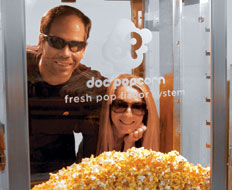There are two ways to sell fast food: get customers to come to your location, or go where people already are. The throngs at fairs, festivals, sporting events, and other gatherings—especially during the summer and fall—have become a tempting target for more quick-service operators.
Going where the crowds are can pose big challenges to the routine processes that allow quick serves to survive on thin profit margins. Still, franchisors and franchisees alike insist that taking their fare out to ready-made gatherings is one of the most effective marketing methods they can use.
“I may spend $300 or $400 on an event—$500 with labor—but it’s well spent,” says Troy Sheller, area director of four Teriyaki Experience stores in Florida. “I have a captive audience walking by me, stopping and tasting, and buying my food. And I know that a lot of them are going to go spend money at my fixed stores.”
Becoming effective crowd pleasers requires quick-serve operators to master several dynamics. First among them is selecting the right events and matching brand, menu, and capabilities to the affair. The biggest rule: Make sure no direct competitors are going to be at the same event.
Operators should also ensure that the crowd fits their target demographic. Steph Olson, a Häagen-Dazs franchisee in Edina, Minnesota, operates completely on a nonfixed-site basis, but at only two events a year: the Minnesota State Fair and Rock the Garden at the Walker Art Center in nearby Minneapolis. The latter draws “an upscale crowd and a highly educated one,” Olson says. “Everyone has money. If I were to go to an Ozzy Osbourne concert instead—not so much.”
Managing expectations must also be part of the pre-event mindset. “It can be great and profitable, but if it is a weekend festival, and it rains for two straight days, your profitability is going to be dampened,” says Dan Ogiba, director of franchise development for Minneapolis-based Häagen-Dazs. “And don’t put all your eggs in one basket. If you’re going to invest in doing any event, do a number of different ones.”
Mobile capabilities must allow operators to function satisfactorily in event environments. For its cart unit, for instance, Doc Popcorn engineered a scaled-down version of the popping system its franchisees use at their fixed stores so that the overall mobile unit could fit into a trailer. The Boulder, Colorado–based chain also adapted its recipes to the resulting smaller batches.
Paciugo Gelato & Caffe designed three types of carts and maintains an inventory of 20 carts in the Dallas area where the gelato chain has its headquarters. One of them is small enough to operate on 110-volt electricity and be transported in any vehicle that has a wheelchair lift. Local franchisees can use the carts free of charge for charity events, but must rent them from Paciugo for corporate affairs.
Paciugo works proactively to help franchisees prepare for the challenges and unpredictability of events. It prepared a checklist to help operators price their appearances, plan work schedules, and react to emergencies.
“We tell them what they should do if the lights go off or the temperature inside the venue goes up,” says Cristiana Ginatta, Paciugo’s cofounder. “And a cell phone number where they can reach us if nothing else works.”
Experimenting with and adjusting the preparation and service of food while ensuring the integrity of all of the particulars of the brand experience is half the battle for quick serves. Paciugo franchisees who initially used an inexpensive dipping cabinet to house gelato at events found that the temperature was too cold, and the gelato would get too soft after it was scooped. So the franchisor developed smaller versions of the curved-glass display cases used at Paciugo’s fixed stores.
For Teriyaki Experience franchisees, replicating the freshly prepared noodle bowls, soups, and other menu items might seem daunting. But Sheller made key adjustments that help his flexibility and speed without hurting food quality. He rents flat-top grills and has them delivered to and set up at sites, rather than purchase his own six-foot piece of heavy equipment to drag all over Florida. He does haul his own rice cookers, which are far more portable.
Sheller’s staff prepares plenty of the chain’s signature sauces at the store in advance of an event. They also precook quantities of each type of meat used in Teriyaki Experience dishes, keep it in chafing vessels at the venue, and then heat it up quickly before serving it as part of an entrée.
“It’s the same food, but people at a stadium don’t want to have to wait five minutes for their meal,” Sheller says.
Lori Bagwell, a Charley’s Subs operator in Carson City, Nevada, sometimes has to improvise to accommodate event settings, but tries to turn it into a marketing opportunity. At one recent event, she was unable to prepare and sell the chain’s signature french fries because the fast food row couldn’t accommodate fryers.
“So I gave everyone a coupon for free fries or $1 off a sandwich if they came into our store,” Bagwell says. “I was hoping my little hook would say, ‘If you liked our sandwiches, you should try our fries.’”
One of the biggest learning curves for crowd-pleasing quick serves is figuring out how to deal with surges of customers. Cutting prep time as Teriyaki Experience’s Sheller did helps. But knowing when customers are coming is just as important so the operation can be stocked and have all hands on deck.
At the weekend youth soccer tournaments frequented by Doc Popcorn franchisee Scott Suryan, predictable rushes come at mid-morning, midafternoon, and evening.
“The presumption people make is, ‘If they’ve got the longest line, what they’ve got must be good,’” says Portage, Michigan–based Suryan. “So we want to create a steady flow of customers toward those lines. We know when we pop the corn that the smell will travel and coax people to come.”













